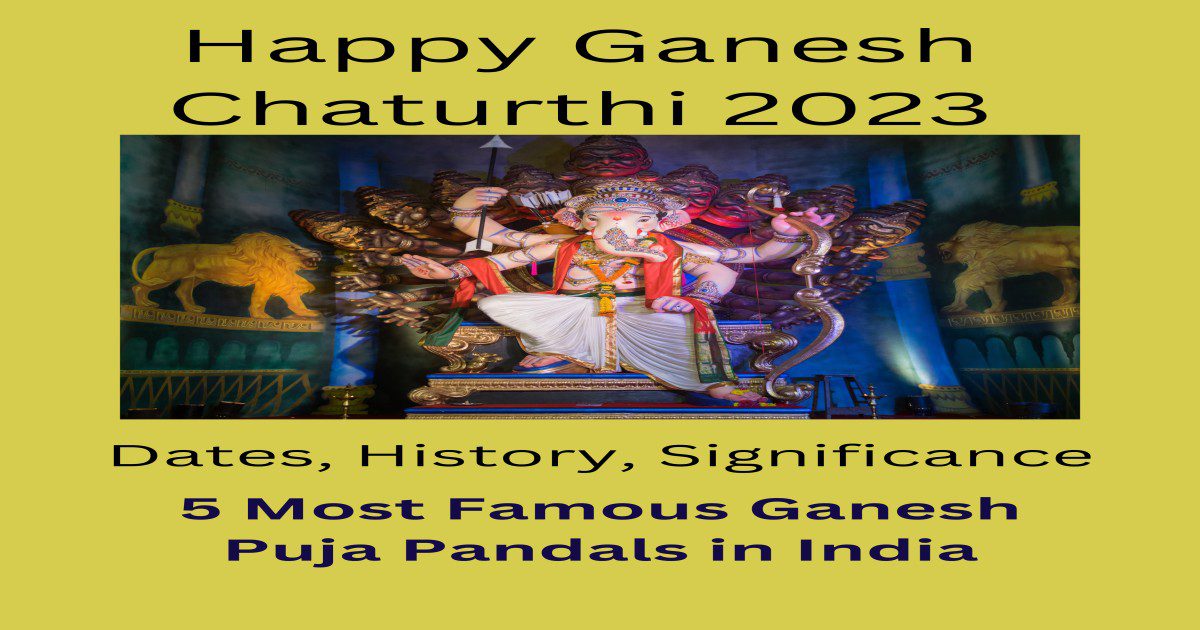Ganesh Chaturthi: The auspicious Hindu festival of Ganesh Chaturthi is celebrated annually with pomp in India. Also known as Vinayaka Chaturthi or Ganesh Utsav, the day marks the birth of Lord Ganesha and is observed for ten days by devotees. It falls annually on the Chaturthi tithi of Shukla Paksha. The last day of the 10-day celebrations is marked as Ganesh Visarjan. On this day, devotees immerse Lord Ganesha’s idols in water.
While Ganesh Chaturthi is commemorated all across the country, it happens on a grand scale in Maharashtra, Telangana, and Karnataka, especially in cities like Mumbai, Pune and Hyderabad. If you are celebrating the festival with your family, know about its date, history, significance, and celebrations inside.
Ganesh Chaturthi 2023
Ganesh Chaturthi begins on September 19 and ends on September 28. The Ganesh Puja muhurat will start at 11:01 am and end at 1:28 pm on September 19. Additionally, the Chaturthi Tithi will start on September 18 at 12:39 pm and end on September 19 at 1:43 pm, according to Drik Panchang.
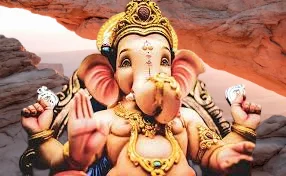
Ganesh Chaturthi History and Significance:
Lord Ganesha is the god of wisdom, knowledge, prosperity and happiness. As per the legend, Maa Paravati created Lord Ganesha with sandalwood paste. It is believed that she left Lord Ganesha to guard the place while she was taking a bath. Since Lord Shiva was not present at this time, he did know about this arrangement. When he returned, he was surprised to find Lord Ganesha outside the place where Maa Parvati was taking a bath.
When Lord Ganesha did not allow Lord Shiva to enter the place he was furious and severed Ganesha’s head. Maa Parvati was infuriated to see this and took the Kaali avatar while threatening to end the world. After finding the truth, Lord Shiva requested his men to fetch the head of a child whose mother was looking the other way. His men returned with the head of a baby elephant and gave it to Ganesha. That’s how Lord Ganesha came to be known as the elephant-headed god.
Ganesh Chaturthi holds immense spiritual and cultural significance for Hindus. Lord Ganesha, the son of Lord Shiva and Goddess Parvati, is believed to bless his devotees with wisdom, success, and good fortune. Devotees seek Lord Ganesha’s blessings before starting any work, exam, wedding or new job.
Ganesh Chaturthi Celebrations:
Ganesh Chaturthi is marked with much fervour across the country, especially in Maharashtra, Telangana, and Karnataka. To celebrate Ganesh Chaturthi, people bring idols of Ganpati Bappa to their homes for one-and-a-half days, three days, seven days, or ten days. The festival ends with Ganesh Visarjan, during which devotees immerse Lord Ganesha’s idols in water with heavy hearts, wishing for Bappa to return next year. Huge processions are held during Visarjan with people chanting ‘ Ganapati Bappa Morya, Purchya Varshi Laukariya’.
Lord Ganesha, as per belief, is also known as Vighnaharta or the one who removes all obstacles. He holds great significance in Hinduism where almost all rituals begin with his worship. Celebrations for this festival begin months in advance with the preparation of idols of Lord Ganesha.
Ganesh Chaturthi has four main rituals — Pranapratishtha, Shodashopachara, Uttarpuja, and Visarjan puja. People decorate their homes with flowers and rangoli designs and bring clay idols of Lord Ganesha, into their homes. Beautifully decorated Ganesh idols are also placed at puja pandals, homes, offices, and educational institutions on the day of Chaturthi.
The Pranapratishtha ritual is performed by a priest by chanting a mantra. After that, 16 different rituals are performed – known as Shodashopachara puja. Modak, a popular sweet dumpling from Maharashtra, is said to be the favourite prasad of Lord Ganesh. Modak and other sweets and fruits are offered to Lord Ganesh during the puja.
People celebrate the festival by singing and playing religious hymns, dancing to drum beats, and preparing a delicious meal. The third main ritual of Ganesh Chaturthi is Uttarpuja – which is about bidding farewell to Lord Ganesh.
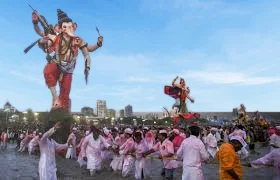
On the 10th and last day of Ganesh Chaturthi, the idol of Lord Ganesha is immersed in a nearby river with full devotion, and this ceremony is called Ganesh Visarjan. People chant “Ganapati Bappa Morya, Purchya Varshi Laukariya”, which means “Goodbye Lord Ganesha, please come back next year.”
| Ganesh Chaturthi in Recent Years |
| 2020 – Saturday, 22 August |
| 2021 – Friday, 10 September |
| 2022 – Wednesday, 31 August |
| 2023 – Tuesday, 19 September |
| 2024 – Saturday, 7 September |
| 2025 – Wednesday, 27 August |
| 2026 – Monday, 14 September |
| 2027 – Saturday, 4 September |
| 2028 – Wednesday, 23 August |
| 2029 – Tuesday, 11 September |
| 2030 – Sunday, 1 September |
The Ganeshotsav, the festivity of Ganesh Chaturthi, ends after 10 days on Anant Chaturdashi which is also known as Ganesh Visarjan day. On Anant Chaturdashi, devotees immerse idol of Lord Ganesh in water body after a gala street procession.
Ganapati Sthapana and Ganapati Puja Muhurat
Ganesh Puja is preferred during Madhyahna as it is believed that Lord Ganesh was born during Madhyahna Kala. Madhyahna Kala is equivalent to midday according to Hindu division of the day.
As per Hindu time-keeping, the time duration between sunrise to sunset is divided into five equal parts. These five parts are known as Pratahkala, Sangava, Madhyahna, Aparahna and Sayankal. Ganapati Sthapana and Ganapati Puja on Ganesha Chaturthi are done during Madhyahna part of the day and as per Vedic astrology it is considered the most appropriate time for Ganesha Puja.
During midday, Ganesha devotees perform detailed ritualistic Ganesha Puja which is known as Shodashopachara Ganapati Puja.
Prohibited Moon Sighting on Ganesha Chaturthi
It is believed that one should not sight the moon on Ganesh Chaturthi. Sighting moon on Ganesh Chaturthi creates Mithya Dosham or Mithya Kalank which means false accusation of stealing something.
As per Puranic legends, Lord Krishna was falsely accused of stealing precious jewel named Syamantaka. After seeing plights of Lord Krishna, Sage Narada informed that Lord Krishna sighted moon on the day of Bhadrapada Shukla Chaturthi and because of that he has been cursed with Mithya Dosha.
Sage Narada further informed Lord Krishna that God Chandra has been cursed by Lord Ganesha that anyone who sighted moon on Shukla Chaturthi during Bhadrapada month would be cursed with Mithya Dosha and would be tainted and dishonoured in the society. On the advice of sage Narada Lord Krishna observed Ganesha Chaturthi fasting to get rid of Mithya Dosha.
Top 5 Famous Ganpati Pandals Across India to Visit this Ganesh Chaturthi 2023
Ganesh Chaturthi, a joyous and revered festival in India, marks the birth of Lord Ganesha, the remover of obstacles and the harbinger of prosperity. During this ten-day celebration, magnificent Ganpati pandals adorned with ornate decorations and vibrant idols of Lord Ganesha spring up across the country. These top 10 famous Ganpati pandals in India offer a mesmerizing glimpse into the cultural extravaganza that unfolds during Ganesh Chaturthi. Devotees and tourists flock to these pandals to seek blessings, immerse themselves in the festive spirit, and partake in the grandeur of the festivities.
Each pandal exudes a unique charm, combining religious fervor with artistic expressions. From the iconic Lalbaugcha Raja in Mumbai, where wishes are believed to be granted, to the ethereal Siddhivinayak Temple, where the divine aura fills the hearts of devotees, these pandals offer an unforgettable spiritual experience. Pune’s Dagdusheth Halwai Ganpati pandal and the historic Keshavji Naik Chawl Ganpati in Mumbai showcase age-old traditions and cultural heritage.
In Hyderabad, the Khairatabad Ganapathi pandal boasts an awe-inspiring idol crafted with precision, while the Sri Vinayaka Devaru Temple in Bengaluru captivates visitors with its serene ambiance. Mysore Palace in Mysuru adds a royal touch to the celebrations, while Kolkata’s RK Math pandal reflects the city’s vibrant festival spirit.
#1. Lalbaugcha Raja, Mumbai – Famous Ganpati Pandal in India:
Located in Mumbai, Lalbaugcha Raja is one of the most iconic and famous Ganpati pandals in India. Known for its immense size and intricate decorations, this pandal attracts an ocean of devotees during the ten-day festival. The idol of Lalbaugcha Raja is considered to fulfill wishes and is believed to be a wish-granter for many.
Lalbaugcha Raja, located in Mumbai, is one of the most famous and revered idols of Lord Ganesha during the Ganesh Chaturthi festival. The idol is hosted at the Lalbaug market area in central Mumbai and is known for its grandeur and magnificence. This iconic pandal has a rich history dating back to 1934 when it was established by the Kambli family. Lalbaugcha Raja is believed to be a wish-granting deity, and millions of devotees from all walks of life throng to seek blessings and fulfill their desires during the ten-day festival.
The pandal witnesses an extravagant display of artistry, with the idol adorned in opulent clothing, jewelry, and flowers. The atmosphere around Lalbaugcha Raja is electrifying, with fervent chants, melodious bhajans, and vibrant decorations filling the air. The idol’s immersion, known as Visarjan, is a grand affair, attracting massive crowds and marking the conclusion of the festival with immense enthusiasm. Lalbaugcha Raja has become an integral part of Mumbai’s cultural fabric, transcending religious boundaries, and symbolizing the unity and spirit of the city during the auspicious occasion of Ganesh Chaturthi.
#2. Siddhivinayak Temple, Mumbai – Famous Ganpati Pandal in India:
The Siddhivinayak Temple in Mumbai is another significant place of worship dedicated to Lord Ganesha. Devotees from all walks of life visit this temple to seek blessings and witness the grandeur of Lord Ganesha’s idol adorned with precious jewels.
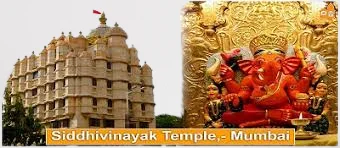
The Siddhivinayak Temple, located in Mumbai, Maharashtra, is one of the most revered and popular Hindu temples dedicated to Lord Ganesha. This ancient temple holds immense significance for devotees and attracts millions of worshippers from around the world. The temple’s history dates back to the 18th century when it was constructed by a local woman named Deubai Patil in 1801. The central deity, Lord Ganesha, is an intricately carved black stone idol, two and a half feet tall, with a trunk turned towards the right. The temple’s name “Siddhivinayak” signifies the granting of wishes and fulfillment of desires, making it a sought-after destination for those seeking blessings and prosperity.
The temple’s architecture reflects a blend of traditional Hindu and contemporary styles, with a stunning façade adorned with intricate carvings and ornate decorations. Inside the temple, the sanctum sanctorum houses the presiding deity, surrounded by silver-plated doors and walls that feature images and motifs from Hindu mythology. The temple complex also includes shrines dedicated to Lord Hanuman, Goddess Durga, and Lord Shani.
Siddhivinayak Temple is not only a place of spiritual significance but also a symbol of Mumbai’s cultural heritage. It has a magnetic pull on people from all walks of life, including celebrities, politicians, and common devotees, who throng to seek blessings, offer prayers, and express gratitude to Lord Ganesha.
Visiting the Siddhivinayak Temple during festivals, especially Ganesh Chaturthi, is a truly enriching experience. The festivities during this time are grand, and the temple witnesses an overwhelming surge of devotees, creating an atmosphere filled with devotion and fervor. The temple trust also engages in various charitable activities, contributing to the welfare of society.
The Siddhivinayak Temple’s sanctity, architectural beauty, and the aura of spirituality make it an iconic landmark in Mumbai and a cherished symbol of faith for millions worldwide. It stands as a testimony to the timeless devotion and love that people hold for Lord Ganesha, the remover of obstacles and the harbinger of good fortune.
#3. Dagdusheth Halwai Ganpati, Pune – Famous Ganpati Pandal in India:
Pune, the cultural capital of Maharashtra, boasts the famous Dagdusheth Halwai Ganpati pandal. This pandal is renowned for its captivating decorations and the massive idol of Lord Ganesha that captures the hearts of devotees.
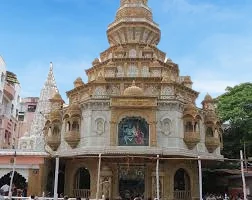
Dagdusheth Halwai Ganpati, situated in Pune, Maharashtra, is one of the most famous and revered temples dedicated to Lord Ganesha. Established by the renowned sweet merchant Dagdusheth Halwai and his wife Lakshmibai in the late 19th century, the temple has a fascinating history and a legacy that continues to attract millions of devotees every year. The temple’s central deity, Lord Ganesha, is an exquisite idol made of gold, adorned with precious jewels, and standing nearly 2.2 meters tall.
The temple’s architecture showcases a blend of traditional Marathi and Mughal styles, featuring intricate carvings, elaborate domes, and a majestic facade. The sanctum sanctorum houses the grand idol of Lord Ganesha, attracting devotees with its divine aura and captivating beauty.
The Dagdusheth Halwai Ganpati temple is renowned for its vibrant celebrations during Ganesh Chaturthi. The ten-day festival witnesses an extravagant display of devotion, culture, and grandeur. Elaborate processions, accompanied by music and dance, carry the beautifully adorned idol through the streets of Pune before its immersion in a nearby water body on the final day.
The temple has become a symbol of faith and unity, attracting people from all walks of life and transcending religious boundaries. Devotees come with prayers and offerings, seeking blessings from Lord Ganesha for various endeavors, be it personal or professional.
Besides its spiritual significance, the temple is also involved in several philanthropic activities, supporting charitable initiatives for the welfare of the community. The Dagdusheth Halwai Ganpati trust actively engages in social causes, providing aid to the underprivileged, supporting education, and aiding medical treatments.
The Dagdusheth Halwai Ganpati temple holds a special place in the hearts of the people of Pune and serves as a beacon of faith and hope for devotees worldwide. Its legacy of devotion, rich heritage, and benevolence make it an iconic landmark and a cherished symbol of devotion to Lord Ganesha, the remover of obstacles and the harbinger of prosperity.
#4. Manache Ganpati, Pune – Famous Ganpati Pandal in India:
Another gem from Pune’s Ganesh Chaturthi celebrations is the Manache Ganpati pandal. This unique tradition showcases ten revered Ganpati pandals, each with its distinct theme and cultural significance. Manache Ganpati, located in Pune, Maharashtra, holds a unique and revered place among the various Ganesh temples in the city. “Manache Ganpati” translates to “Respected Ganpati” in Marathi, and this term is used to refer to a group of eight Ganesh temples that are traditionally worshipped in a specific sequence during the Ganesh Chaturthi festival.
These eight temples are historically significant and have deep-rooted cultural and historical connections with the city of Pune. The tradition of visiting these temples in a specific sequence, known as the “Ashtavinayak Yatra,” dates back several centuries and is considered a sacred pilgrimage for devotees.
The Manache Ganpati temples include Kasba Ganpati, Tambdi Jogeshwari Ganpati, Guruji Talim Ganpati, Kesari Wada Ganpati, Tulshibaug Ganpati, Sarasbaug Ganpati, Shanivar Wada Ganpati, and Alka Chowk Ganpati. Each temple has its unique history, architectural style, and cultural significance.
Devotees undertake the Ashtavinayak Yatra during Ganesh Chaturthi, visiting each temple in the specified sequence to seek blessings from the revered Ganesh idols. The processions during the festival are elaborate and filled with devotion, with the idols adorned with splendid decorations and carried in grand processions through the city’s streets.
Among the Manache Ganpati temples, Kasba Ganpati holds a special place as the first temple to be visited during the Ashtavinayak Yatra. The temple’s history dates back to the 17th century and is believed to be one of the most ancient Ganesh temples in Pune.
The Manache Ganpati temples are not only places of spiritual significance but also represent the rich cultural heritage and history of Pune. They showcase unique architectural styles, intricately carved idols, and are an integral part of the city’s cultural fabric.
Devotees from all over Maharashtra and beyond undertake the Ashtavinayak Yatra with utmost devotion, seeking blessings and divine grace from each of the revered Ganpati idols. The tradition of Manache Ganpati and the Ashtavinayak Yatra have been passed down through generations, fostering a sense of unity, spirituality, and cultural pride among the people of Pune.
The Manache Ganpati temples stand as a testimony to the enduring faith and devotion of the people, and they continue to inspire countless devotees to embark on this sacred journey of seeking the blessings of the revered Ganesha idols in Pune.
#5. Khairatabad Ganapathi, Hyderabad – Famous Ganpati Pandal in India:
Hyderabad’s Khairatabad Ganapathi pandal is an awe-inspiring sight during Ganesh Chaturthi. The pandal houses an enormous idol of Lord Ganesha, which is meticulously crafted by skilled artisans.
Khairatabad Ganapathi, located in Hyderabad, Telangana, is one of the most prominent and largest Ganesh idols in India. The idol, standing tall at around 60 feet, is an awe-inspiring sight that attracts hordes of devotees and tourists during the Ganesh Chaturthi festival. The tradition of installing the Khairatabad Ganapathi idol dates back to 1954 when it was started by the late S. Shankarayya, a local freedom fighter and social activist.
The making of the Khairatabad Ganapathi idol is a labor of love and dedication. It takes months of meticulous planning and skilled craftsmanship to create the massive structure. The idol is crafted using clay, bamboo, and plaster of Paris, and its construction begins well in advance of the festival.
The Khairatabad Ganapathi pandal is an architectural marvel, designed with elaborate decorations and thematic backdrops. Devotees flock to the pandal to seek blessings and offer prayers to Lord Ganesha, the remover of obstacles and the harbinger of good fortune.
The immersion of the Khairatabad Ganapathi idol is a grand spectacle, with a procession that winds through the city’s streets. Crowds gather to bid farewell to the beloved deity, as the idol is carried to the Hussain Sagar Lake for immersion. The event is marked by fanfare, music, and enthusiasm, creating an atmosphere of joy and celebration.
Khairatabad Ganapathi is not just a religious icon; it holds a special place in the hearts of Hyderabad’s residents. It symbolizes the spirit of unity and cultural heritage, bringing people from all communities together to celebrate the festival with zeal and fervor.
Apart from its religious significance, the Khairatabad Ganapathi idol also promotes eco-friendly practices. In recent years, efforts have been made to use eco-friendly materials for the idol’s construction and encourage environmentally conscious celebrations.
The Khairatabad Ganapathi pandal serves as a platform for various social and charitable activities. The organizers often engage in philanthropic endeavors, contributing to the welfare of the community and supporting underprivileged sections of society.
The grandeur and magnificence of Khairatabad Ganapathi make it an iconic symbol of Hyderabad’s cultural and spiritual heritage. The towering idol, the fervent celebrations, and the spirit of devotion and unity make Khairatabad Ganapathi an unforgettable experience for devotees and visitors alike during the auspicious occasion of Ganesh Chaturthi.
Other famous pandals includes, Keshavji Naik Chawl Ganpati, Mumbai, Shree Sarvajanik Ganeshotsav, Goa, Mysore Palace, Mysuru, RK Math, Kolkata and Sri Vinayaka Devaru Temple, Bengaluru.
For more articles please visit read4knowledge.
